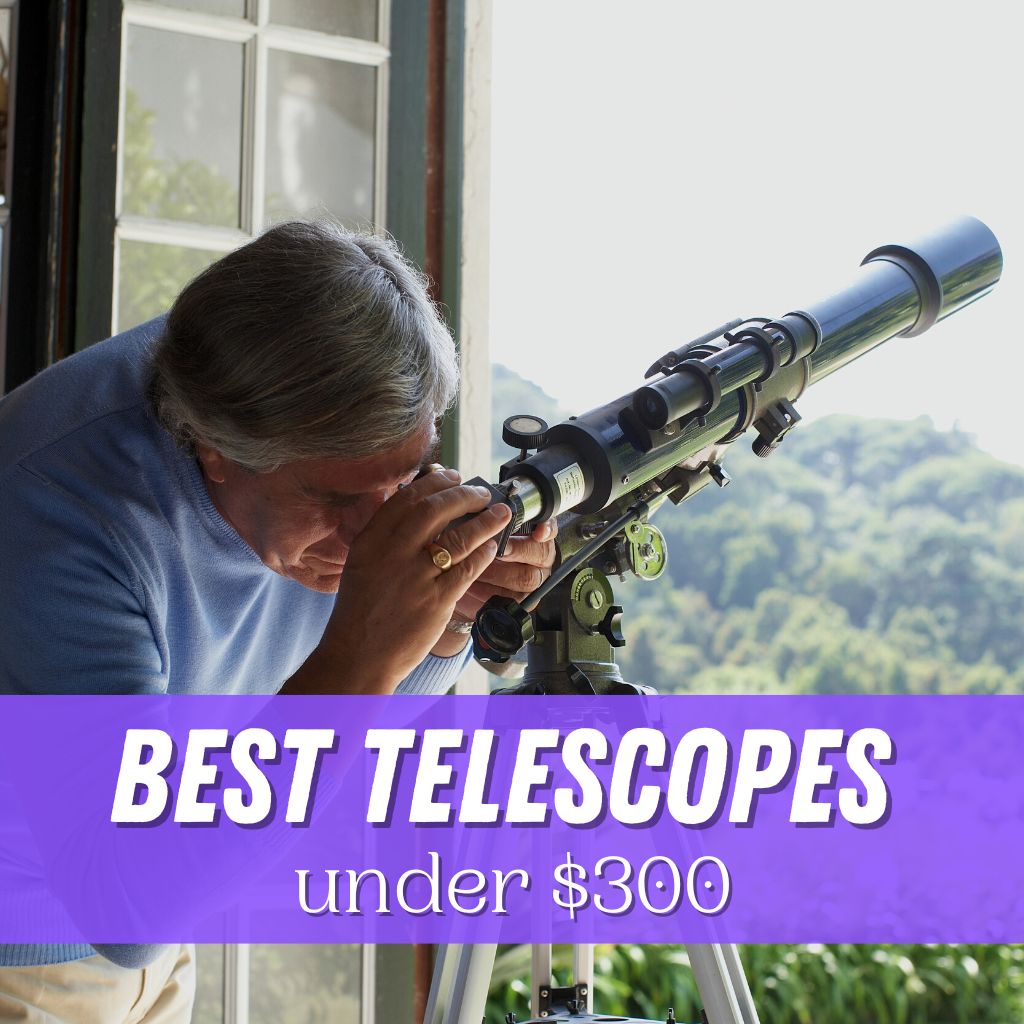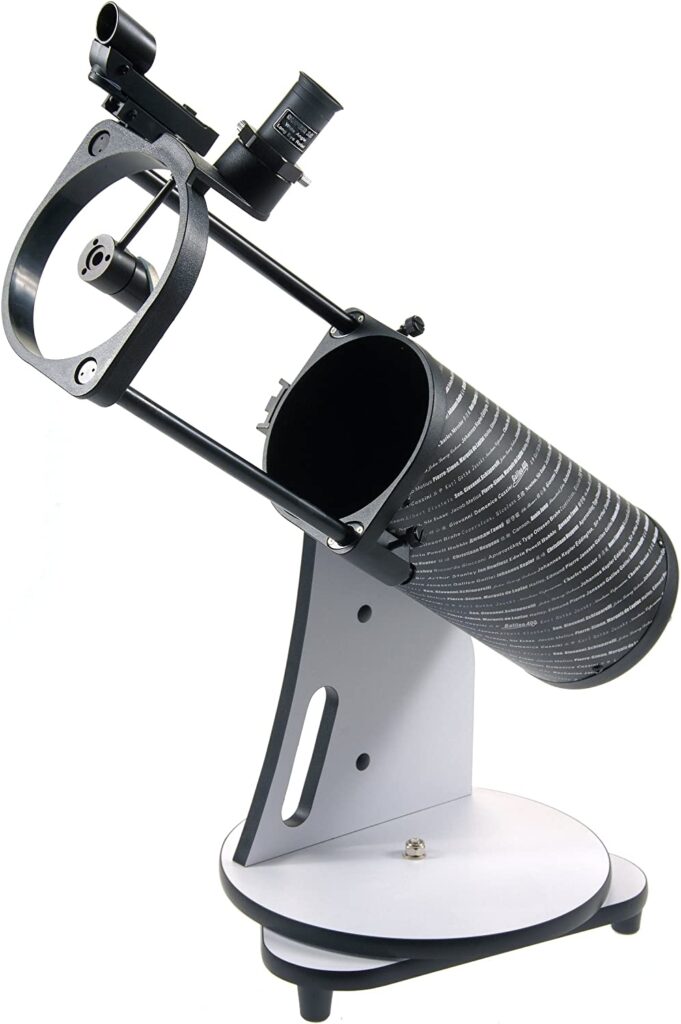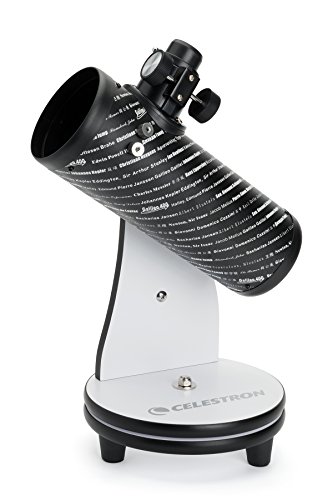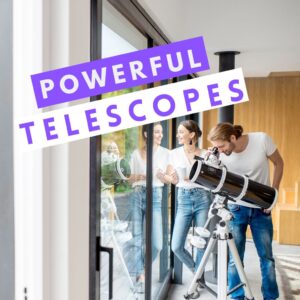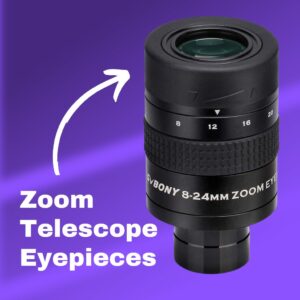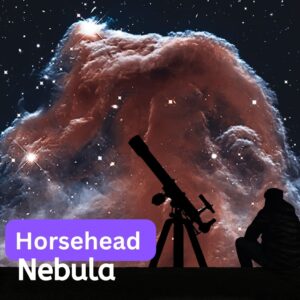This site contains affiliate links to products. I may receive a commission for purchases made through these links.
Owning a telescope to observe the night sky should never be reserved for those with deep pockets. In fact, you can embark on a celestial journey without breaking the bank.
With a myriad of affordable options available, owning a telescope doesn’t have to mean emptying your wallet for a high-end device that costs as much as a small car.
This article presents the best telescopes under $300 to ensure that both beginners and astronomy enthusiasts can gaze at the stars without stretching their budget.
Best refractor telescope under $300
These telescopes combine affordability with impressive optical performance, allowing you to delve into the world of stargazing with a small budget.
These refractor telescopes offer exceptional value for the price with their high-quality lenses, durable construction, and user-friendly features.
Here are some recommended options:
Celestron AstroMaster 70AZ – Best for beginners & lunar viewing
The Celestron AstroMaster 70AZ refractor telescope is a great telescope that is ideal for beginners embarking on their astronomical journeys.
This telescope is specifically designed for those who are eager to explore the lunar landscape and the planets in our solar system.
AstroMaster 70AZ is user-friendly and straightforward to set up without any tools, which makes it ideal for novices.
Its pan-handle alt-azimuth control makes tracking celestial objects a breeze as they move across the night sky.
The two included eyepieces (20mm and 10mm) offer low and high-power views of celestial objects.
The scope comes with a sturdy tripod, providing a stable platform for your observations.
This model doesn’t compromise on quality despite its affordable price. For under $300, this refractor telescope from Celestron is a real catch for beginners, those on a budget, or anyone interested in lunar and planetary viewing.
You may also like: 21 Best Telescopes for Beginners (Ranked!)
The Meade Instruments Infinity 102mm refractor telescope – Best for kids and visual observing
The Meade Instruments Infinity 102mm refractor telescope is a fantastic option for kids. Its 102mm (4-inch) aperture provides bright, clear images of the night sky, but where it really shines is its use as a spotting scope during the day.
The alt-azimuth mount is easy to operate, and the telescope comes with three eyepieces that provide low, medium, and high-powered magnification for viewing a wide range of objects.
Gskyer AZ70400 – Best for casual stargazing
If you’re searching for a budget-friendly refractor telescope that delivers on both terrestrial and celestial viewing, the Gskyer AZ70400 is a solid choice. This telescope sports a 70mm aperture and 400mm focal length, providing clear and bright images.
For terrestrial viewing, the included erect-image diagonal prism ensures the image is correctly oriented, which is perfect for watching birds, landscapes, or distant scenery.
At night, this telescope will offer beautiful views of the moon’s craters and the larger planets in our solar system.
The Gskyer AZ70400 is also ideal for kids and beginners, thanks to its simple setup process and ease of use.
Read also: Gskyer Telescope Models: Your Ultimate Selection Guide
Celestron AstroMaster LT 60AZ Refractor Telescope – Best for beginners
The Celestron AstroMaster LT 60AZ Refractor Telescope is a compact and versatile option for those starting their astronomical journey. With a 60mm aperture and fully coated optics, this telescope delivers bright and detailed views of the night sky.
Its lightweight design and easy setup make it a great choice for on-the-go stargazing. The altazimuth mount enables smooth movements and precise tracking, allowing you to explore a wide range of celestial objects with ease.
Orion Observer 80ST – Best for wide-field viewing
The Orion Observer 80ST is another refractor telescope under $300 that is excellent for wide-field viewing. Its short focal length (400mm) and relatively wide aperture (80mm) make it a great tool for expansive views of the sky, making it perfect for observing larger open star clusters and big, sweeping views of the Milky Way.
The Observer 80ST is lightweight and portable. Therefore, it is a fantastic choice for those who want a telescope they can easily transport for stargazing adventures away from light pollution.
It also comes equipped with two Sirius Plossl eyepieces, offering different magnifications to suit your viewing preferences.
Celestron AstroMaster 80AZS Refractor Telescope – Best for beginner stargazers
The Celestron AstroMaster 80AZS Refractor Telescope is an excellent choice for beginners looking to explore the night sky. With its 80mm aperture and fully coated glass optics, this telescope offers clear, detailed views of celestial objects.
The altazimuth mount and adjustable tripod provide stability and easy maneuverability, making it effortless to track and observe various targets.
Orion 9024 AstroView 90mm Equatorial Refractor Telescope – Best for planetary viewing
Orion’s AstroView 90mm Equatorial Refractor offers beginners a well-crafted, powerful telescope capable of capturing detailed images of the moon, planets, and even some brighter deep-sky objects.
The 90mm aperture refractor telescope features an equatorial mount that allows for smooth manual tracking. Combined with its two included Sirius Plossl eyepieces, it offers high-quality, sharp views that make it ideal for detailed planetary and lunar viewing.
Celestron AstroMaster 90EQ – Best for lunar and planetary viewing
The Celestron AstroMaster 90EQ is a 90mm refractor telescope well-suited for terrestrial and celestial observations. It uses fully coated glass optics to provide crisp and detailed views.
Known for lunar and planetary viewing, its high power can reveal Saturn’s rings and Jupiter’s cloud belts.
Its sturdy equatorial mount and included motor drive help in tracking celestial objects accurately as they move across the night sky.
SOLOMARK 80EQ Refractor Professional Telescope – Best for galaxies, bright planets, and brighter deep sky objects
The SOLOMARK 80EQ Refractor Professional Telescope is designed for adults passionate about astronomy. With a 700mm focal length, this telescope offers exceptional clarity and detail in your observations of the night sky.
The telescope comes with a 1.5X Barlow lens adapter, which allows for enhanced magnification and is also great for astrophotography enthusiasts.
The included 13 Percent Transmission Moon Filter ensures comfortable and optimized views of the Moon, reducing glare and enhancing contrast.
Celestron Inspire 70AZ Refractor Smartphone Adapter Built-In Refracting Telescope – Best in astroimaging for beginners
The Celestron Inspire 70AZ is a refractor telescope that comes with an integrated smartphone adapter, making it an excellent choice for those taking their first steps into astroimaging.
This 70mm aperture telescope captures bright, clear images of celestial objects. Its built-in smartphone adapter allows you to easily capture and share your observations.
The Inspire 70AZ also features fully coated optical glass that provides high transmission coatings for enhanced image brightness and clarity.
It’s an all-round perfect tool for beginners looking to dive into the world of astronomy and astroimaging.
Meade Instruments Polaris 90mm Aperture Refracting Astronomy Telescope – Best for beginners needing high-contrast views
The Meade Polaris 90mm telescope is a refracting telescope that offers beginners the chance to explore the night sky with high-contrast views.
Its 90mm aperture allows it to gather a good amount of light, which results in bright, clear images.
Ideal for backyard stargazing, this telescope comes with a sturdy alt-azimuth mount, making it easy to point and track celestial objects as they move across the sky.
The Polaris 90mm is perfect for beginners starting their astronomical journey.
Celestron Inspire 80AZ – Best for lunar and planetary observation
The Celestron Inspire 80AZ Refractor Telescope steps up the game with an 80mm aperture, allowing more light collection and brighter images.
This telescope is versatile for both daytime terrestrial viewing and night-time astronomical use.
It has two eyepieces and an erect diagonal for correct image orientation during daytime use. It also features an integrated smartphone adapter to capture your observations.
You may also like: 36 Best Refractor Telescopes (Ranked!)
Best reflector telescope under $300
Finding a quality reflector telescope under $300 is an exciting possibility for astronomy enthusiasts on a budget. These telescopes offer good value for money while providing considerable performance and versatility.
Here are some good options:
Orion 09007 SpaceProbe 130ST – Best for bright deep sky objects
The Orion 09007 SpaceProbe 130ST is a highly popular reflector telescope perfect for deep sky observing. This telescope allows a substantial amount of light in, providing views of bright deep-sky objects like galaxies, nebulae, and star clusters.
This model stands out due to its short tube design and long focal length (650mm), making it portable and capable of high magnification.
It comes with two eyepieces (25mm and 10mm) for varied magnification options and a 6×30 finder scope to easily locate and center celestial objects.
Celestron AstroMaster 114 EQ – Best for beginners
The Celestron AstroMaster 114 EQ combines user-friendly features with the ability to deliver bright, clear images of the night sky, making it perfect for beginners.
It features a large 114mm aperture and a German equatorial mount for easy tracking of celestial objects as they move across the sky.
This telescope’s high-quality optics are great for viewing the moon’s craters, Saturn’s rings, and a range of deep-sky objects like galaxies and nebulae.
The package also includes two eyepieces (20mm and 10mm), providing different magnifications to suit your needs.
Celestron AstroMaster 130EQ Newtonian Telescope – Best for beginners
The Celestron AstroMaster 130EQ is a Newtonian reflector telescope designed specifically for astronomy beginners who don’t want to compromise on their viewing experience.
It sports a large 130mm aperture that brings in plenty of light to make distant celestial bodies like galaxies and nebulae bright and detailed.
With its German Equatorial mount and easy-to-use manual tracking, beginners can smoothly follow celestial objects as they move across the sky.
This telescope offers high-quality views that can inspire a lifelong love of stargazing and astronomy.
Meade Instruments Polaris 127mm- Best for beginners
The Meade Polaris 127mm telescope is a reflecting telescope designed with beginners in mind who are keen on deep sky observations.
With its substantial 127mm aperture, this telescope can gather more light, providing bright and detailed views of distant celestial objects like galaxies and nebulae.
Like its 90mm counterpart, it comes with a reliable mount for easy tracking of celestial objects, but its larger aperture puts the wonders of the deeper universe within your reach.
It’s a good choice for beginners aiming to dive deeper into the cosmos from their backyard.
Celestron StarSense Explorer LT 114AZ Smartphone App-Enabled Telescop e- Best for viewing stars and planets
The Celestron StarSense Explorer LT 114AZ offers a unique telescope experience with its integrated smartphone dock. The StarSense Explorer app uses your smartphone’s capabilities to analyze star patterns overhead and calculate their position in real time.
This 114mm reflector telescope provides bright, clear images of the moon and planets and even offers glimpses of nebulae and galaxies.
Meade Polaris 114 mm German EQ Reflector – Best for budding astrophotographers
The Meade Polaris 114 mm is a good reflector telescope equipped with a German Equatorial mount for easy tracking of celestial objects. The 114mm aperture allows for great light-gathering capabilities to provide bright and detailed images.
It comes with three eyepieces providing low, medium, and high-powered magnification. The ability to track objects smoothly makes this telescope suitable for astrophotographers.
Celestron PowerSeeker 127 EQ – Best for planets, moon, and Orion Nebula
Celestron’s PowerSeeker 127 EQ is a Newtonian reflector telescope with a 127mm aperture that delivers bright, detailed views of celestial objects.
This telescope is ideally suited for intermediate astronomers with a solid understanding of star navigation.
The equatorial mount offers manual slow-motion tracking of celestial objects. The Barlow lens that comes with the package triples each eyepiece’s magnification, offering greater versatility in viewing.
Read the detailed review: Celestron PowerSeeker 127EQ Review (Before Purchasing)
Orion StarBlast 4.5 Astro – Best for Moon, planets, and bright deep sky objects
The Orion StarBlast 4.5 Astro is for those upgrading from a beginner’s telescope and seeking a balance between power, convenience, and affordability.
This reflector telescope features a sizable 4.5-inch aperture that collects a significant amount of light, providing clear and bright views of the moon, planets, and even some deep-sky objects like nebulae and galaxies.
Its compact tabletop design and simple point-and-view navigation get it ready for observing in minutes, making it ideal for impromptu stargazing sessions.
This telescope demonstrates that upgrading your gear doesn’t necessarily mean complicating your stargazing experience.
Best compound (catadioptric) telescope under $300
Catadioptric telescopes combine the best features of refractor and reflector telescopes, resulting in an optical system ideal for providing detailed views of various celestial objects.
These telescopes correct many optical issues, such as chromatic aberration, providing a sharp, high-contrast image. Under $300, numerous Catadioptric telescope options strike a balance between quality and affordability.
Let’s explore some of the best options available.
SARBLUE Mak60 Catadioptric Compound Telescope – Best for kids and beginner astronomers
The SARBLUE Mak60 Catadioptric Compound Telescope is an excellent choice for both adults and kids who are beginning their journey into astronomy.
With a 60mm aperture and a focal length of 750mm, this telescope offers clear and detailed views of celestial objects.
Its Maksutov-Cassegrain design combines the advantages of both refractor and reflector telescopes, ensuring crisp images and a compact form factor.
The telescope comes with a tabletop tripod and a phone adapter, allowing you to capture and share your observations with ease.
Orion StarMax 90mm Mak-Cass Telescope – Best for Moon and bright planets
Orion’s StarMax 90mm is a Maksutov-Cassegrain telescope that offers powerful views in a compact package. This 90mm-aperture telescope excels at long-distance terrestrial viewing and detailed lunar and planetary observations.
Its tabletop design makes it easy to use from a deck, patio, or picnic table. It’s particularly noted for its portability, making it a favorite for campers and hikers.
SARBLUE Maksutov-Cassegrain Telescope 60 with Dobsonian Mount-Best for beginners
The SARBLUE Maksutov-Cassegrain Telescope 60 is another great option for beginners interested in astronomy. Featuring a 60mm aperture and a focal length of 750mm, this telescope provides clear and bright views of the night sky.
It comes with a Dobsonian mount, which offers stability and simplicity of use, meaning it is a great choice for beginners.
A finderscope and phone adapter are included, enhancing the telescope’s functionality and making it easier to locate and photograph celestial objects.
The compact tabletop design makes it convenient for both kids and adults to enjoy astronomy from anywhere.
Best portable telescope under $300
Portable telescopes are perfect for camping trips, backyard observations, or even taking on the go for spontaneous stargazing sessions.
With a budget of $300 or less, you can still find telescopes that offer impressive features and performance.
Here are some recommended options:
Celestron 21035 70mm Travel Scope – Best for terrestrial and celestial objects
The Celestron 21035 70mm Travel Scope is an excellent choice for stargazers on the move. This compact and lightweight telescope comes with a carrying case, making it easy to transport and ideal for camping trips, holidays, or any outdoor adventures.
Despite its small size, this telescope doesn’t skimp on quality. It features a 70mm aperture, providing clear and bright views of the moon, planets, and some brighter deep-sky objects.
It also comes with two eyepieces (20mm and 10mm), allowing for different magnification options.
Orion SkyScanner 100mm TableTop Reflector Telescope – Best lunar, planets, and deep-space nebulas
If you’re short on space, the Orion SkyScanner 100mm TableTop Reflector Telescope is a great pick. This compact telescope, with its 100mm aperture, packs a punch and provides detailed views of the Moon, bright planets, and even some nebulae and star clusters.
Its small size and tabletop design make it perfect for city dwellers who want to indulge in a spot of stargazing from their balcony or small backyard.
The SkyScanner is also very lightweight and easy to transport, making it ideal for spontaneous observing sessions or trips out of town.
Read the entire review here: Orion SkyScanner 100mm Telescope Review (Read this first!)
Meade Instruments 206002 Adventure Scope 80mm – Best for field trips
The Meade Instruments 206002 Adventure Scope is another portable telescope perfect for field trips. With an 80mm aperture, this refractor telescope offers clear, bright images of celestial objects.
What sets the Adventure Scope apart is its included backpack and durable tripod, making it perfect for adventurers.
The full-sized tripod is adjustable and includes a panhandle control, allowing for smooth and accurate pointing.
Celestron AstroMaster LT 70AZ Refractor Telescope – Best for use on the go
The Celestron AstroMaster LT 70AZ Refractor Telescope is designed with beginners in mind, offering a perfect balance of affordability and functionality.
Its 70mm aperture and coated glass optics provide crisp and sharp views of celestial wonders. The Alt-Azimuth mount allows for smooth and intuitive navigation, making it ideal for capturing stunning views of the Moon, planets, and other celestial objects.
Its lightweight and portable design makes it easy to transport and set up, ensuring that you can enjoy astronomy anywhere you go.
Read the complete review: AstroMaster LT 70AZ Telescope Review (Before Purchasing)
SVBONY 60mm Portable Refractor Telescope – Best for backyard viewing sessions
SVBONY 60mm Portable Refractor Telescope is a compact and user-friendly telescope that’s perfect for introducing novices to the wonders of the night sky.
With its 60mm aperture and multi-coated optics, this refractor telescope delivers clear, bright images of the moon, stars, and planets. It’s easy to set up and comes with an adjustable tripod, making it perfect for backyard viewing sessions.
The SVBONY Telescope is an ideal tool for beginners, offering an engaging and educational experience that can spark a lifelong interest in astronomy.
Meade 114 mm LightBridge Mini – Best for viewing planets, star clusters, and nebulae
Meade’s LightBridge Mini 114 is ideal for astronomers who value portability. This compact tabletop reflector telescope features a sizable 114mm parabolic aperture.
It captures enough light for great views of the moon, planets, and even some brighter deep-sky objects like nebulae and galaxies. Its small size and lightweight design make it easy to carry to your favorite stargazing spot.
Celestron 80mm Travel Scope – Best for casual stargazing
The Celestron Travel Scope 80 is an excellent choice for those seeking a telescope that is compact, portable, and easy to use yet powerful enough to deliver great skygazing experiences.
This scope offers an 80mm aperture and comes with a custom backpack to safely store and transport your telescope and accessories.
The telescope includes two high-quality eyepieces (20mm and 10mm) that provide low- and high-power views of celestial objects.
Emarth Telescope 70mm/360mm – Best for kids
The Emarth Telescope, with a 70mm aperture and 360mm focal length, is another excellent option for travel and is particularly suited to kids and beginners.
Its compact and lightweight frame and adjustable tripod make it an ideal telescope for family camping trips or remote stargazing adventures.
The telescope has two eyepieces (10mm and 25mm) and a 3x Barlow lens. These allow for a range of magnification options and provide clear and bright views of the moon, planets, and certain deep sky objects.
This telescope also comes with an easy carry bag for travel and storage convenience.
SVBONY SV25 Kids Telescope – Best portable telescope for kids
The SVBONY SV25 Kids Telescope is a perfect choice for beginner adults and children alike. With a 60mm aperture, it provides clear views of celestial objects such as the Moon and planets.
The telescope comes with a tripod for stability and a finder scope for easier object location. It also includes two eyepieces for versatile magnification options.
Sky-Watcher Heritage 130P – Best for beginners
Sky-Watcher’s Heritage 130P is a travel-friendly reflector telescope that perfectly blends portability and power. With its 130mm aperture, this telescope gathers enough light to provide bright, clear images of the moon, planets, and even some deep-sky objects.
It features a collapsible design for easy transport and storage. Its collapsible design further enhances its convenience, allowing for easy transport and storage.
The Sky-Watcher Heritage 130mm Telescope combines compactness, versatility, and performance, making it an excellent companion for stargazing adventures.
Celestron 76mm Classic FirstScope Telescope – Best for kids and beginners
The Celestron 76mm Classic FirstScope Telescope is a top pick for kids and beginners venturing into the world of astronomy. Designed with simplicity in mind, this telescope offers a user-friendly experience that encourages exploration.
Its compact and portable design makes it convenient for on-the-go observations, allowing budding astronomers to take their stargazing adventures wherever they please.
Don’t let its small size fool you—this telescope delivers impressive views of the moon, stars, and planets.
Zhumell Z100 Portable Altazimuth Reflector Telescope – Best for stargazing events
The Zhumell Z100 Portable Altazimuth Reflector Telescope is the perfect choice for stargazing events and gatherings. With its impressive 100mm parabolic primary mirror, this telescope excels in capturing ample light, resulting in bright and detailed views of celestial objects.
Its altazimuth mount allows for smooth and precise movements, making it easy to point and track objects in the sky.
The telescope’s compact design adds to its appeal, as it can be easily transported to star parties, camping trips, and other outdoor events.
Read also: Zhumell Telescopes: Complete Model Lineup (Explained!)
Orion GoScope III 70mm Refractor Travel Telescope – Best for traveling
For those moon enthusiasts who love to travel, the Orion GoScope III 70mm is a perfect fit. This compact telescope comes with a specially designed backpack for secure transport and easy storage.
The GoScope III includes two eyepieces (20mm and 9mm) for varied magnification. Its 70mm objective lens gathers enough light to reveal lunar details, star clusters, and even some bright nebulae.
The included Orion MoonMap 260 helps beginners learn the main lunar features and the best times to observe them.
In conclusion, selecting the perfect telescope depends on your specific interests, lifestyle, and budget. However, with the plethora of quality options available under $300, you’re sure to find a telescope that will enrich your stargazing experience and deepen your love for astronomy.
Upgrading from a $100 telescope model: Next steps
After mastering the use of a $100 beginner telescope, you might find yourself yearning for more. An upgrade can offer enhanced optics, better tracking, larger apertures, and an overall improved viewing experience.
Taking the leap from a beginner telescope to a more advanced model involves several key factors to consider.
Let’s dive in to help you make an informed decision about your telescope upgrade.
Aperture size
When upgrading your telescope, one of the first aspects to consider is the aperture size. A larger aperture allows for brighter and more detailed views of celestial objects.
Optics quality
The quality of optics is crucial in a telescope. High-quality optics reduce aberrations such as chromatic aberration (color distortion) and provide sharp, high-contrast images. Look for telescopes with coated or multi-coated optics.
Mount type
The mount type is another critical consideration. Equatorial mounts, for instance, are aligned with the Earth’s rotation and make it easier to track celestial objects across the sky. Altazimuth mounts are simpler and great for beginners but require more manual adjustment.
Additional accessories
Upgrading your telescope often means getting additional accessories. These can include extra eyepieces for different magnifications, a Barlow lens to increase the power of your eyepieces, filters for enhanced contrast, and star charts or apps to help locate celestial objects.
Celestron PowerSeeker Accessory Kit is a good option. This kit includes a variety of accessories such as a case, eyepieces, and filters to enhance your stargazing experience.
FAQs
Let’s address some frequently asked questions:
What can I expect to see with a telescope under $300?
With a telescope under $300, you can expect to see an array of celestial objects. These include the Moon’s surface in great detail, planets such as Mars, Venus, Jupiter, and Saturn, including Jupiter’s moons and Saturn’s rings.
Brighter deep sky objects like nebulae, star clusters, and even some galaxies are also within reach of a quality telescope in this price range.
Is a more expensive telescope always better?
A more expensive telescope is not always better. The best telescope for you depends on your individual needs, including your level of expertise, the specific celestial bodies you’re interested in observing, and the level of portability or stability you require.
A high-quality budget telescope can often serve a beginner or intermediate astronomer just as well as a more expensive model.
What are the essential accessories I need for a telescope?
Essential accessories for a telescope include:
- Eyepieces and filter: These determine the magnification and field of view of your telescope. A filter allows you to enhance or selectively observe specific wavelengths or reduce unwanted effects such as light pollution or glare. The Celestron – 1.25” Eyepiece and Filter Accessory Kit is a good option.
- Barlow lens: This is used to double or triple the magnification of your eyepieces. The Celestron Omni 2X Barlow Lens is a great example.
- Finder scope: This helps you aim your telescope at the desired object. The Telrad Finder Sight is a popular.
- Star Maps or Apps: These guide you in locating celestial objects.
What is the best budget telescope?
Here are some recommended options:
Can I see Saturn with a cheap telescope?
You can see Saturn with a cheap telescope. Even a budget-friendly telescope can provide a view of Saturn that reveals its rings, albeit as a small, bright object.
Can I see planets with a cheap telescope?
You can see planets with a cheap telescope. With a budget telescope, you should be able to observe details like the moons of Jupiter, the rings of Saturn, and the phases of Venus.
Mars and Mercury are also visible but appear smaller and offer less detail.
You may also like: Can I See Planets With a Cheap Telescope?
Can I see the stars with a cheap telescope?
A budget-friendly telescope can provide clear views of the stars. While individual stars will still look like points of light (as they are too far away to be resolved into disks), a telescope will reveal many more stars than are visible with the naked eye.
You’ll also be able to explore double and variable stars, open clusters (like the Pleiades), and globular clusters.
Takeaway: Enjoy the views of celestial objects without emptying your wallet with the best telescopes under $300
Exploring the night sky doesn’t have to be a costly endeavor. As we’ve seen throughout this article, there are numerous high-quality telescopes available under $300, each with its own unique set of features and benefits.
If you’re a novice astronomer starting on your stargazing journey, an experienced observer looking for a portable solution, or a parent hoping to ignite a love of astronomy in your children, there’s a telescope out there to meet your needs.
The portable and travel options further ensure that your astronomical explorations aren’t limited to your backyard.
While making a choice, remember to consider the purpose, your observing preferences, and the level of commitment you’re ready to invest in this fascinating hobby.
Accessories like different eyepieces, a Barlow lens, a moon filter, and star maps can greatly enhance your viewing experience.
You may also like:

